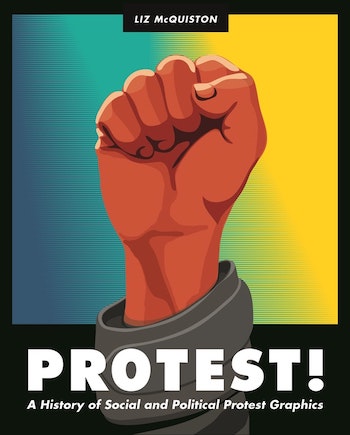Book Review: “Protest! A History of Social and Political Protest Graphics” — Pavlovian Calls to Action
By Robert Israel
Liz McQuiston writes that the posters collected in her book are meant to “pay tribute to the liberating concept of hard-won ‘freedom of speech’ throughout history.”
Protest! A History of Social and Political Protest Graphics, by Liz McQuiston. Princeton University Press, $39.95.

The best political and social protest posters fuse words and bold graphics in order to deliver an emotional wallop. Yes, when competing for attention with messages flashed on neon and video Jumbotrons, they take second place. Yet never underestimate their primal power: eye-catching posters plastered onto the sidewalls of buildings or mounted on wooden sticks at protest rallies still command attention, even stirring controversy.
Protest! chronicles the subversive origins of protest posters from the 14th to the 21st century. The resulting history lesson is simultaneously painful and triumphant. The volume features a generous sampling of color and black-and-white reproductions along with well-researched and informative texts. Bittersweet memories are aroused, no doubt plunging some readers back into a remembrance of chaotic times past. And, of course, the book forces us to look at the social and political conflagrations that are coming at us daily. Protest! suggests that the imagination will be powerful enough to respond — with savage vim and vigor — to future indignities and injustices.
I first witnessed the profound effect of political posters when I visited the Imperial War Museum in London a few years ago.
Integrating bold typography with colorful rotogravure images, the exhibit focused on World War II posters that were once displayed in public squares or affixed to bus and railway station kiosks. Designed to inspire citizen resolve, they protested the destruction perpetrated by the Invading Huns, the Murderous Nazis. I remember one in particular that showed the image of a somber Winston Churchill, Royal Air Force planes flying heroically high above him. Below his bulldog countenance these words: “Let Us Go Forward Together.”
But, while I was swept up by the artistic quality of these posters, I had the leisure to walk away from their patriotic fervor, to return, footloose, to the peacetime streets of London. A post-World War II brat, the only comparative emotional experience I could draw on was at the Army induction center on Niagara Street in Providence. While parading past the Army desk sergeants in my skivvies, I saw hanging on the wall a poster by James Montgomery Flagg of a pugnacious Uncle Sam, sleeves rolled up, the words “I want YOU!” emblazoned in patriotic red, white, and blue. Flagg’s poster did not rouse in me the same fervor to join the Armed Forces as it did my father, who served in WWII. On the contrary, what Flagg’s poster engendered in me was dread. Uncle Sam’s finger may have been pointing at me, but his steely gaze seemed to be focused on the killing fields of Vietnam.

McQuiston’s book reproduces a scathing parody of Flagg’s famous poster, designed by artist Seymour Chwast. Created in 1967 ,his image neatly combines patriotism and destruction, depicting Uncle Sam in a toothpaste advertisement. It reads: “End Bad Breath.” Inside of Uncle Sam’s mouth are Air Force bombers defoliating a field in Vietnam. Our symbolic patriarch seems to be enjoying the carnage — perhaps digesting it. He anticipates the character of Col. Kilgore, (played by Robert Duval) in Apocalypse Now, who declares, “I love the smell of Napalm in the morning.”
Another poster from that era reproduced in the book, designed by Dirty Linen Corp., presents a photomontage of a young man burning his draft card accompanied by the words “Fuck the Draft.” Seeing these posters brought back memories of my huddling in a dormitory room at college, while Rep. Alexander Pirnie pulled numbers from the U.S. Selective Service’s fishbowl. Turns out I had fetched a high number; I could finish my degree. But several of my classmates weren’t so lucky: they would soon board a bus bound for basic training.
Protest! is not just about nostalgia. It is about how posters memorably articulate popular dissent today. There are compellingly stinging caricatures of President Donald Trump, particularly a brash poster that turns him into a zombie. Designed by artist Mitch O’Connell, the latter image appeared on a popular T-shirt. Riffing off of James Montgomery Flagg’s Uncle Sam poster, O’Connell whips up whirling patriotic colors in the background. The message is suitably brash: “Make America TRUMP Great Again.”
McQuiston writes that the posters collected in Protest! are meant to “pay tribute to the liberating concept of hard-won ‘freedom of speech’ throughout history.… The power struggles of the past,” she adds, “and their visual communication, have meaning for us now.” They certainly do. We live in an era, not unlike others that have preceded this one, when Armageddon — unleashed by an unstable, authoritarian leader — is a real possibility. Posters are Pavlovian wake-up calls, visceral shout-outs to action — before it is too late.
Robert Israel writes about theater, travel, and the arts, and is a member of Independent Reviewers of New England (IRNE). He can be reached at risrael_97@yahoo.com.
